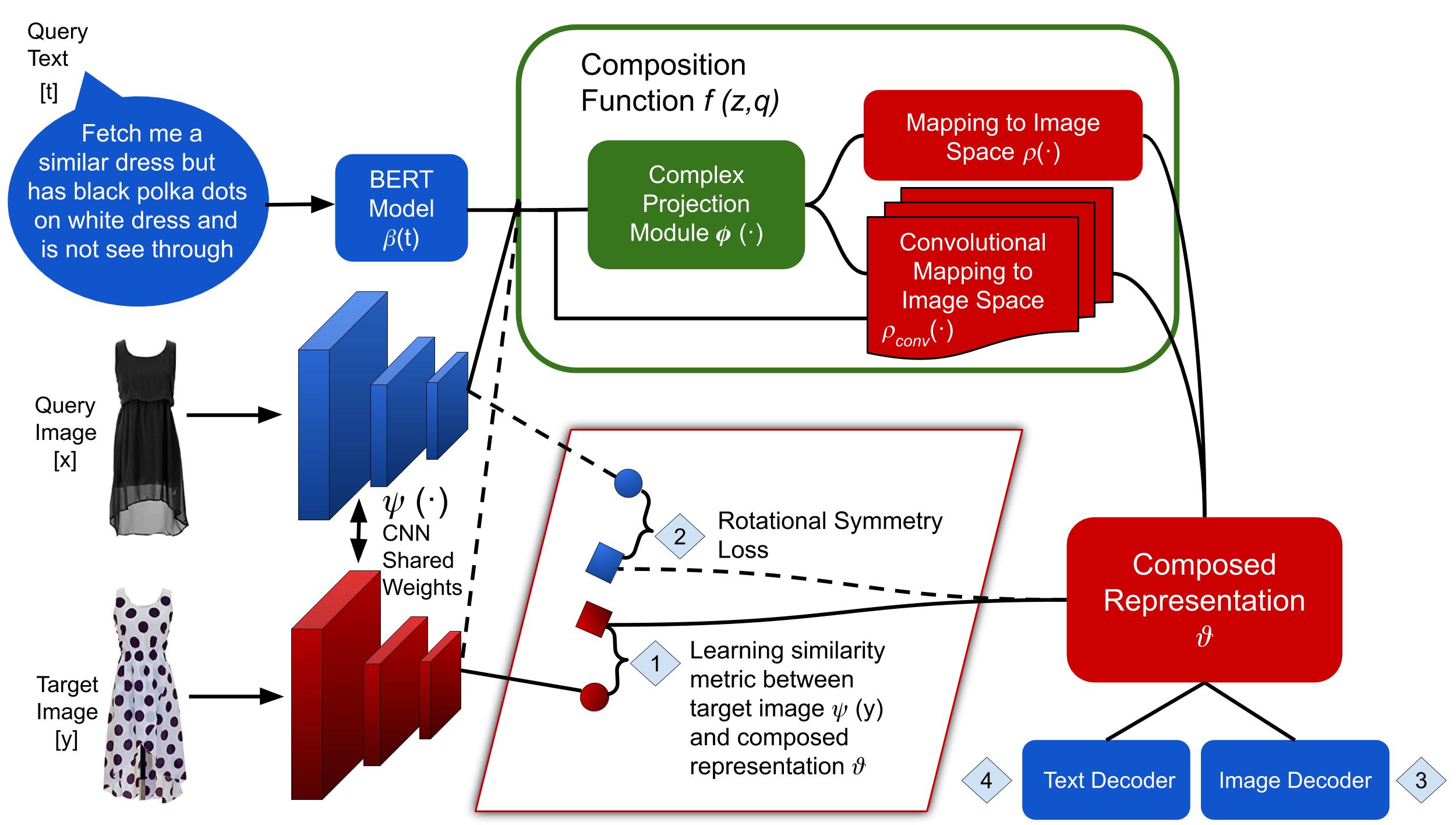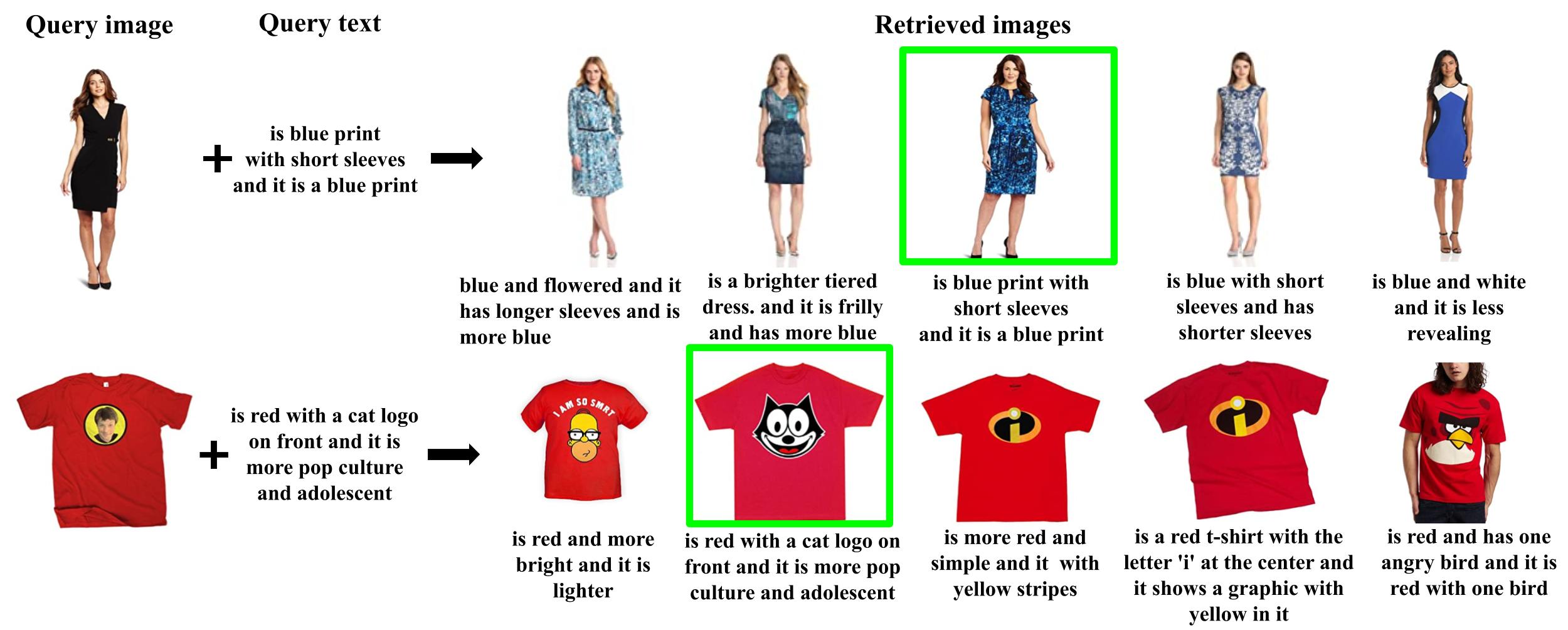The paper can be accessed at: https://arxiv.org/pdf/2006.11149.pdf. This is the code accompanying the WACV 2021 paper: Compositional Learning of Image-Text Query for Image Retrieval.
One of the peculiar features of human perception is multi-modality. We unconsciously attach attributes to objects, which can sometimes uniquely identify them. For instance, when a person says apple, it is quite natural that an image of an apple, which may be green or red in color, forms in their mind. In information retrieval, the user seeks information from a retrieval system by sending a query. Traditional information retrieval systems allow a unimodal query, i.e., either a text or an image.
Advanced information retrieval systems should enable the users in expressing the concept in their mind by allowing a multi-modal query.
In this work, we consider such an advanced retrieval system, where users can retrieve images from a database based on a multi-modal (image-text) query. Specifically, the query text prompts some modification in the query image and the task is to retrieve images with the desired modifications. This task has applications in the domain of E-Commerce search, surveillance systems and internet search.
The figure shows a potential application scenario of this task. In this figure a user of an E-Commerce platform is interested in buying a dress, which should look similar to her friend’s dress, but the dress should be of white color with a ribbon sash. In this case, we would like the algorithm to retrieve some dresses with desired modifications in the query dress.
We propose an autoencoder based model, ComposeAE, to learn the composition of image and text query
for retrieving images. We adopt a deep metric learning approach and learn a metric that pushes composition
of source image and text query closer to the target images. We also propose a rotational symmetry constraint
on the optimization problem.

Our approach is able to outperform the state-of-the-art method TIRG on three benchmark datasets, namely: MIT-States, Fashion200k and Fashion IQ.
Some qualitative retrieval results on FashionIQ dataset are shown below:

- Python 3.6
- PyTorch 1.2.0
- NumPy (1.16.4)
- TensorBoard
- Other packages can be found in requirements.txt
Description of the Code (From TIRG)
The code is based on TIRG code.
Several significant changes have been made in every file.
Important classes such as ComposeAE, ComplexProjectionModule etc have been added.
datasets.py and test_retrieval.py have been modified to add Fashion IQ dataset.
main.py: driver script to run training/testingdatasets.py: Dataset classes for loading images & generate training retrieval queriestext_model.py: LSTM model to extract text featuresimg_text_composition_models.py: various image text compostion modelstorch_function.py: contains soft triplet loss function and feature normalization functiontest_retrieval.py: functions to perform retrieval test and compute recall performance
Download the dataset via this link and save it in the data folder. Kindly take care that the dataset should have these files:
data/mitstates/images/<adj noun>/*.jpg
Download the dataset via this link and save it in the data folder.
To ensure fair comparison, we employ the same test queries as TIRG. They can be downloaded from here. Kindly take care that the dataset should have these files:
data/fashion200k/labels/*.txt
data/fashion200k/women/<category>/<caption>/<id>/*.jpeg
data/fashion200k/test_queries.txt`
Download the dataset via this link and save it in the data folder.
The dataset consists of three non-overlapping subsets, namely dress, top-tee and shirt.
We join the two annotations with the text and it to get a description similar to a normal sentence a user might ask on an E-Com platform.
Furthermore, we combine the train sets of all three categories to form a bigger training set and train a single model on it.
Analogously, we also combine the validation sets to form a single validation set.
For training and testing new models, pass the appropriate arguments.
For instance, for training original TIRG model on MITStates dataset run the following command:
python -W ignore main.py --dataset=mitstates --dataset_path=../data/mitstates/ --model=tirg --loss=soft_triplet --learning_rate_decay_frequency=50000 --num_iters=160000 --weight_decay=5e-5 --comment=mitstates_tirg_original --log_dir ../logs/mitstates/
For training TIRG with BERT model on MITStates dataset run the following command:
python -W ignore main.py --dataset=mitstates --dataset_path=../data/mitstates/ --model=tirg --loss=soft_triplet --learning_rate_decay_frequency=50000 --num_iters=160000 --weight_decay=5e-5 --comment=mitstates_tirg_bert --log_dir ../logs/mitstates/ --use_bert True
For training TIRG with complete text query on MITStates dataset run the following command:
python -W ignore main.py --dataset=mitstates --dataset_path=../data/mitstates/ --model=tirg --loss=soft_triplet --learning_rate_decay_frequency=50000 --num_iters=160000 --weight_decay=5e-5 --comment=mitstates_tirg_complete_text_query --log_dir ../logs/mitstates/ --use_complete_text_query True
For training ComposeAE model on Fashion200k dataset run the following command:
python -W ignore main.py --dataset=fashion200k --dataset_path=../data/fashion200k/ --model=composeAE --loss=batch_based_classification --learning_rate_decay_frequency=50000 --num_iters=160000 --use_bert True --use_complete_text_query True --weight_decay=5e-5 --comment=fashion200k_composeAE --log_dir ../logs/fashion200k/
For training RealSpaceConcatAE (ComposeAE model but with Concatenation in Real Space) on FashionIQ dataset run the following command:
python -W ignore main.py --dataset=fashionIQ --dataset_path=../data/fashionIQ/ --model=RealSpaceConcatAE --loss=batch_based_classification --learning_rate_decay_frequency=8000 --num_iters=100000 --use_bert True --use_complete_text_query True --comment=fashionIQ_RealSpaceConcatAE --log_dir ../logs/fashionIQ/
ComposeAE uses pretrained BERT model for encoding the text query. Concretely, we employ BERT-as-service and use Uncased BERT-Base which outputs a 768-dimensional feature vector for a text query. Detailed instructions on how to use it, can be found here. It is important to note that before running the training of the models, BERT-as-service should already be running in the background.
Run the following command for monitoring loss and retrieval performance of the models:
tensorboard --logdir ./logs/fashion200k/ --port 8898
If you find this code useful in your research then please cite
@InProceedings{Anwaar_2021_WACV,
author = {Anwaar, Muhammad Umer and Labintcev, Egor and Kleinsteuber, Martin},
title = {Compositional Learning of Image-Text Query for Image Retrieval},
booktitle = {Proceedings of the IEEE/CVF Winter Conference on Applications of Computer Vision (WACV)},
month = {January},
year = {2021},
pages = {1140-1149}
}


